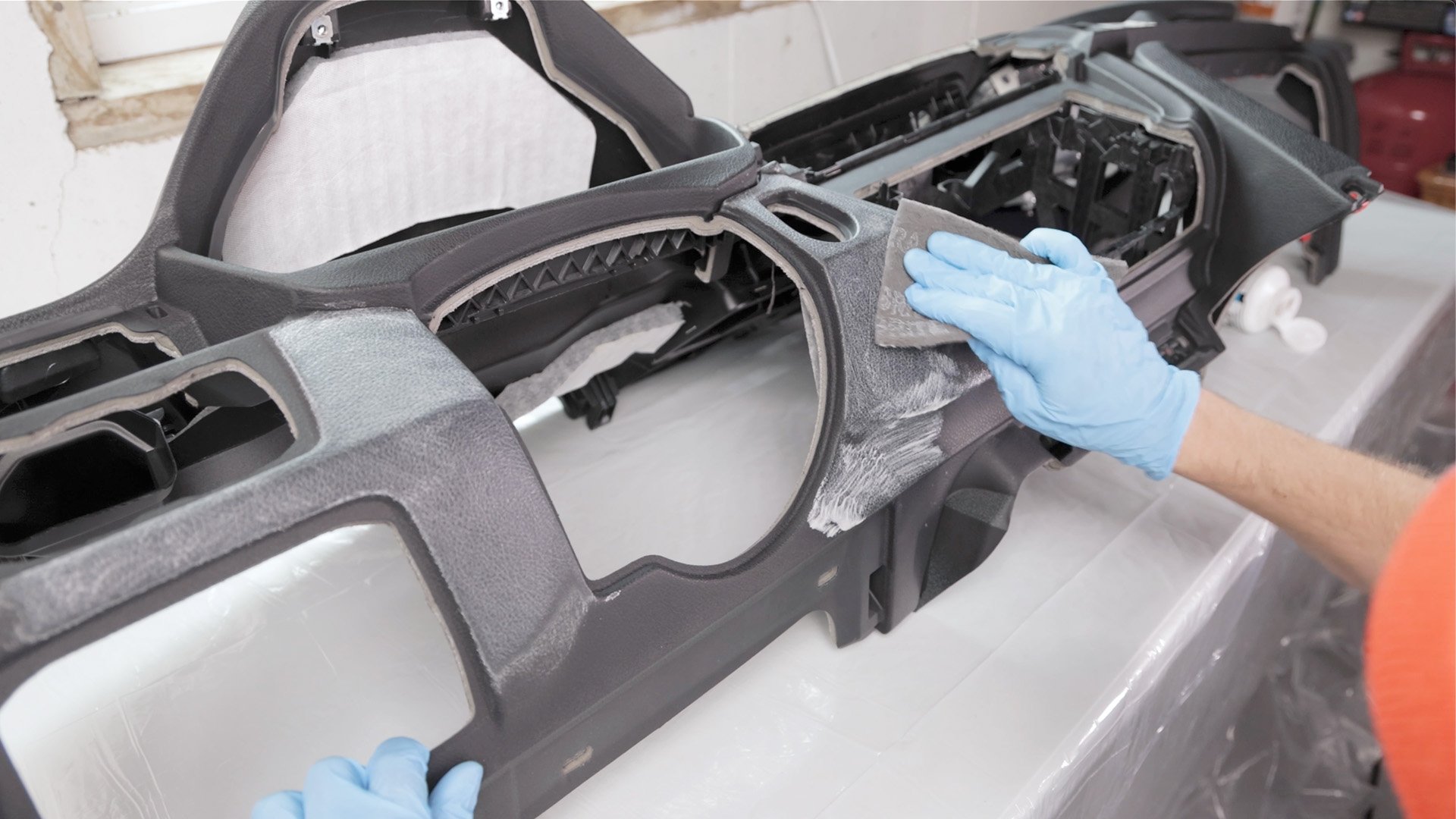Affiliate disclosure: This blog contains affiliate links. If you click my custom link to buy a product, I’ll earn a commission at no extra cost to you. WIN!
If you’ve ever thought about painting your dashboard, center console, or door panels you’ve come to the right place. When I bought my F30 3 Series a few years ago, I went out of my way to find one with a Coral Red interior. In my opinion, it’s the most exciting color that BMW offered for this generation. One thing I never understood though, is why the F32 4 Series got a matching Coral Red dashboard, while the 3 Series just got a plain black dash.
Over the years, I have checked prices of used Coral Red dashboards, but they’ve always been just a little more than I cared to spend at around $500-600. I came across a company called Colorbond that sells interior spray paint in OEM colors, and to my surprise, they had my Coral Red paint. I ordered a can and tested it on some old interior parts, and the color was a perfect match!
In this blog, I’ll walk you through the process of prepping and painting the dashboard (or any ABS plastic interior parts). In case you’re wondering how I got the dashboard out of the car to paint it, check out my step-by-step dashboard removal guide here.
what you’ll need:
Colorbond offers different kits depending on the type of material you’re painting. For my dashboard, I chose the kit for "plastic substrates” which is what the surface of the dashboard is. The plastics kit included 1 can of Coral Red paint, 1 can of adhesion promoter, 1 can of UV resistant matte clear coat, and 1 bottle of concentrated cleaner. There are a handful of other supplies you will need that are linked below.
NOTE: The paint kit includes only 1 can of paint. Because my red paint didn’t cover well, I ultimately used 3 cans total. If you are painting the color red, or painting a large surface area, order more paint than you think you’ll need so you don’t run out!
Scuffing paste https://amzn.to/4fVbGhp
Grey scuff pads https://amzn.to/3Wi0m8b
N95 masks https://amzn.to/4h9Aof2
Gloves https://amzn.to/3WiQFGC
Spray bottle (x3) https://amzn.to/3DU8Dsz
Microfiber towels https://amzn.to/4jgJIiW
Blue painter’s tape https://amzn.to/3DSYkoK
Plastic drop cloth https://amzn.to/4fYlSWC
Dashboard painting guide
Work in a well ventilated area and wear personal protective equipment!
Step 1: Prep the surface with scuffing paste. Scuffing paste is essentially 800 grit sandpaper in liquid form. The idea here is to be able to scuff up the dash surface, while preserving faux leather texture. The paste combined with the flexible, cloth-like scuff pads is able to get deep into that grain unlike regular sandpaper. Another benefit of the paste is I could visually see what areas were done and which ones still needed attention.
Step 2: Rinse off the scuffing paste with plain water.
Step 3: Clean the dashboard with the prep cleaner included in the kit. The cleaner is concentrated. I added 1 oz of cleaner concentrate to my 32 oz spray bottle.
Step 4: Clean the entire dashboard once more with isopropyl alcohol. This will remove any remnants of the cleaner and the dash will finally be ready for paint. You may want to go over the dashboard with a hairdryer to ensure all of the crevices are completely dry. Pro Tip: For each step mentioned above, I used a different colored microfiber so I wouldn't cross contaminate.
Step 5: Carefully mask off anything you don’t want to get paint on. I used a large plastic tarp to cover the top of the dashboard, and attached it with blue painter’s tape.
Warning: For the following steps, wear a mask and work in a well ventilated area. I had my egress window open with a box fan pointing out to evacuate the fumes.
Step 6: Spray adhesion promoter in two light coats at a distance of 8-10 inches. Several light coats are better than one heavy one. Car interior plastics are notoriously difficult to paint, but this adhesion promotor is supposed to help the paint bond to the surface material.
Step 7: Apply a light mist coat of paint. We will start light and gradually build up, allowing 5 minutes in between coats.
Colorbond claims that most colors should cover in two coats, however, red paint can be a difficult color to work with in terms of coverage. I ended up doing six coats in total.
Step 8: Once you’re satisfied with the paint coverage, it’s time to apply the clear coat. The clear coat included in the kit is UV resistant, so it should help preserve the red color while adding a layer of durability. I opted for a matte finish clear. I did two coats of clear total.
Re-installation: I allowed the paint to dry and off-gas for a few days before reinstalling the dashboard in the car. After the install, I left the car windows rolled down (inside my garage) for a week or so to minimize the paint smell. About a month after this project, there is no smell at all.
Gallery
Final thoughts and tips
This project was a big undertaking but I learned a lot and have a few tips for anyone looking to do this on their own car.
It ended up making a big mess in my basement. If I could do it again, I would have done it in my garage with the cars pulled outside. If you don’t have a garage, you could buy a small tent and use that. I would advise against just painting outside in the open due to bugs, pollen and other environmental factors.
I wish I had better lighting. Another problem with trying to do this in my basement was that I just didn’t have enough light to see what I was doing. There were some areas where I used more paint than I needed because the light was playing tricks on my eyes. There were areas that looked like they weren't getting good coverage, but in reality, it only looked dark because of how the dim basement lights were casting a shadow.
I should have pulled the table away from the wall so I could paint 360 degrees around the dashboard, rather than just spraying it from the bottom. Now that it’s installed in the car, there are a few spots I noticed where the coverage is rather light. Had I sprayed the dashboard from all angles, I could have had more even coverage.
I was talking to my friend who’s a professional car painter about the red paint coverage issue. He suggested that in hindsight, it might have been better to prime the dashboard with white or light grey paint first, rather than trying to go right from black to red. In Colorbond’s official demo video, they are spraying beige paint over black and it covered with ease. So I don’t think the issue I had is a reflection of Colorbond’s quality, I think it’s the color red that was problematic.



















